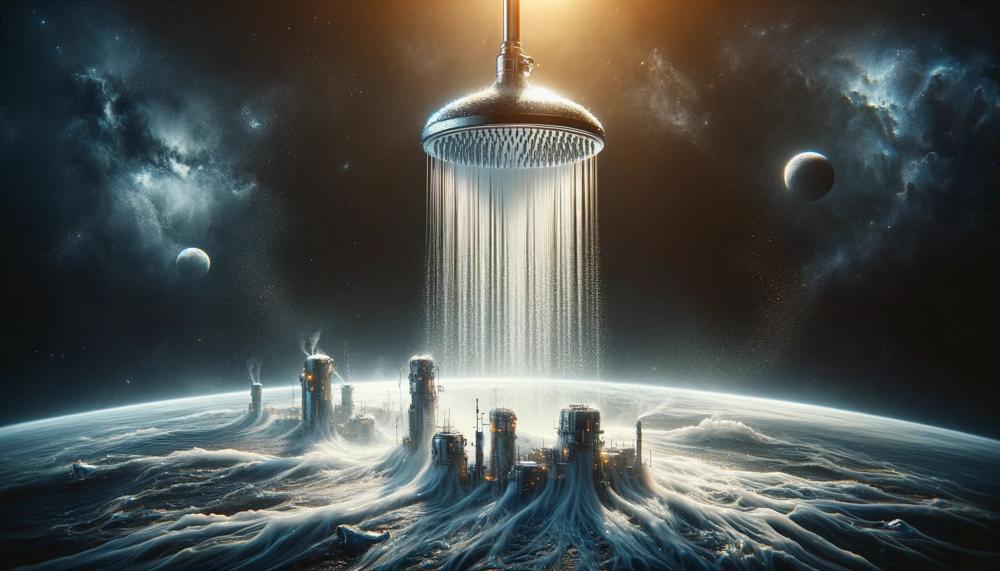Imagine stepping into your shower, ready to kickstart your morning with a refreshing cleanse, only to be greeted by silence instead of the familiar sound of water cascading from the showerhead.
This scenario, frustrating as it may be, is more common than you might think and can throw a wrench into anyone’s daily routine.
In this blog post, we’ll dive deep into the mysteries behind why your showerhead has decided to go on a strike, leaving you high and dry when you least expect it.
From the simple to the complex, we’ll cover a range of reasons why water has stopped flowing and, more importantly, provide you with practical solutions to get things running smoothly again.
By the end of this article, you’ll gain valuable insights into:
- The Importance of Regular Maintenance: How routine checks can prevent major mishaps.
- Common Culprits Behind the Problem: Identifying issues from mineral buildup to faulty plumbing.
- DIY Fixes vs. When to Call the Pros: Guidance on tackling the issue yourself and recognizing when it’s time to seek professional help.
- Preventative Measures for the Future: Tips to avoid a repeat performance and ensure a steady flow in your shower.
Whether you’re a DIY enthusiast or someone who prefers to leave it to the professionals, this guide will equip you with the knowledge needed to address one of the most annoying household issues.
Let’s get started and turn that trickle of frustration into a flood of relief.
Contents
Diagnosing Your Shower Head Issue

To tackle the nuisance of a non-functioning shower head, embark on a systematic quest to unearth the culprit. Below, you’ll find a guide crafted to navigate this conundrum with precision.
Initial Inspection:
- Check other faucets for water flow to determine if the issue is isolated to the shower.
- If no water is flowing elsewhere, the main water supply or pipes may be at fault. Contact a plumber if this is the case.
Shower Head Examination:
- If only the shower head is affected, detach it and look for mineral buildup or blockages.
- Utilize a toothpick or brush to clear away debris from the openings.
Deep Clean Solution:
- Soak the shower head in a vinegar solution to dissolve stubborn mineral deposits.
Flow Restrictor Check:
- Investigate the shower head for a flow restrictor, which might be clogged. Clean or remove this component as necessary.
Diverter Valve Dilemma:
- If the diverter valve is faulty, it may hinder water flow to the shower head. Refer to your shower’s manual or seek professional assistance for repair.
Water Pressure Probe:
- Low overall water pressure in your home can affect shower performance. Measure the pressure or consult with your water provider for insights.
Remember, while these steps can often lead to a resolution, some situations may require the expertise of a plumber.
Shower Pressure Too Low/No Water Coming Out of Showerhead
Troubleshooting and fixing low water pressure or no water coming out of your showerhead requires a bit of sleuthing and a hands-on approach.
Here’s a concise guide to get your shower back to its glory.
Check the Basics First
Before diving deeper, let’s check the simplest fixes:
- Shut-off Valve: Make sure it’s fully open. Sometimes, it’s partially closed after maintenance.
- Clogged Aerator: Unscrew the showerhead and inspect the aerator for debris. Clean it if necessary.
Diagnosing the Root Cause
If the basic checks don’t improve the situation, it’s time to dig deeper:
| Issue | Symptom | Fix |
| Clogged Showerhead | Water trickles out. | Soak in vinegar overnight and scrub. |
| Faulty Diverter Valve | Water comes from the tap, but not the showerhead. | Replace or repair the valve. |
| Pressure Regulator Issues | Low pressure in multiple fixtures. | Adjust or replace the regulator. |
| Pipe Damage | No water or very low pressure in all fixtures. | Inspect pipes for damage or leaks; may require a plumber. |
Wider Issues?
Sometimes the problem isn’t just with your shower:
- Neighbourhood Check: Ask around. If your neighbours are experiencing similar issues, it might be a municipal water supply problem.
- Water Company: Contact them to inquire about any work or issues in your area that could be affecting your water pressure.
Prevent Future Issues
Keep your plumbing in top condition to prevent future low pressure woes:
- Regularly clean aerators and showerheads.
- Inspect pipes annually for signs of damage or leaks.
- Consider installing a water softener if you live in a hard water area to reduce mineral buildup.
In case you’re out of your depth, it’s wise to call in a professional. A plumber can identify and solve complex issues more efficiently than the untrained eye.
Shower Head is Dripping or Leaking
Fixing a Dripping or Leaking Shower Head
To address a dripping or leaking shower head, the issue often stems from a build-up of limescale or a faulty washer. Here’s a straightforward guide to mend this hiccup, ensuring your shower is back to its best.
Step-by-Step Guide:
- Detach the Shower Head: Unscrew the shower head from the hose or wall. This process might require a wrench or pliers, but be gentle to avoid damage.
- Apply Limescale Remover: Use a quality limescale remover to treat the shower head. Spray it liberally and leave it to work its magic for about an hour. This step helps in dissolving any stubborn mineral deposits.
- Scrub and Rinse: Post limescale treatment, take a stiff brush and give the shower head a good scrub. Focus on the nozzles where clogs are common. Rinse it thoroughly afterwards.
- Inspect and Replace the Washer: The washer, a small rubber disc, can often be the culprit behind leaks. Inspect it for any signs of wear, damage, or cracks. If it looks compromised, replace it with a new one.
- Reassemble and Test: Put all the parts back together and reattach the shower head to its place. Turn on the shower to check if the leaking or dripping persists.
If after these steps the drip persists, it might be time to seek help from a professional. Sometimes, the issue could be more complex, involving the shower’s internal plumbing. Remember, a small leak not only wastes water but can also lead to bigger plumbing problems down the line.
Shower Water Pressure is too High
Excessive shower water pressure can feel invigorating yet might lead to unforeseen trouble. Here’s how you can tell if the pressure’s too much:
- Unusual Noises: Listen for banging or clattering in your pipes, known as water hammer.
- Rapid Deterioration of Appliances: If devices like your shower head, dishwasher, or washing machine break down often, blame it on the pressure.
- Sudden Surges: A fierce blast of water upon turning on the shower hints at pressure spikes.
Solving the Pressure Puzzle
Should you discover your shower acting more like a pressure washer, here’s what you can do:
| Check the Pressure | Use a pressure gauge on an outdoor spigot. Ideal readings are between 40-60 PSI. | DIY |
| Adjust the Regulator | Turn the valve on your pressure regulator to lower the setting. Remember, righty-tighty increases pressure, lefty-loosey decreases it. | DIY or Professional |
| Inspect the Shower Head | Look for a displaced washer or misalignment in the restrictor. | DIY |
| Professional Inspection | If DIY tweaks don’t cut it, call in the experts. They can spot and fix deep-seated issues like a faulty regulator. | Professional |
Keep It Under Control
Remember, high pressure isn’t just about the thrill of a powerful shower; it’s a signal. It might tell tales of hidden troubles in your pipes or mishaps waiting to happen. Regular checks and balances can save your sanity and your wallet.
If you’re near hills or a fire hydrant, stay extra vigilant. High water pressure might be lurking, ready to pounce on your plumbing’s weak spots. So, tackle it head-on, be it with a wrench or a phone call to a plumber.
Conclusion
Navigating the perplexity of a shower head that refuses to disburse water can be both bewildering and irritating.
This challenge, however, is not insurmountable. The key to unlocking a steady cascade of water lies in understanding the myriad of factors that can lead to such a predicament.
From mineral deposits barricading the path of water flow to more intricate plumbing conundrums, each potential cause demands its own unique solution. Regular maintenance emerges as a cornerstone strategy, not only offering a solution but also acting as a preventive measure against future occurrences.
The article meticulously guides you through the steps necessary to diagnose and remedy a malfunctioning shower head. Whether the solution requires a simple DIY fix, like immersing the shower head in vinegar to dissolve mineral build-up, or necessitates the expertise of a professional plumber for more complex issues, the guidance provided arms you with the knowledge to restore harmony to your shower experience.
Additionally, it underscores the importance of vigilance and regular checks to ensure that your shower remains a source of rejuvenation, rather than frustration.





